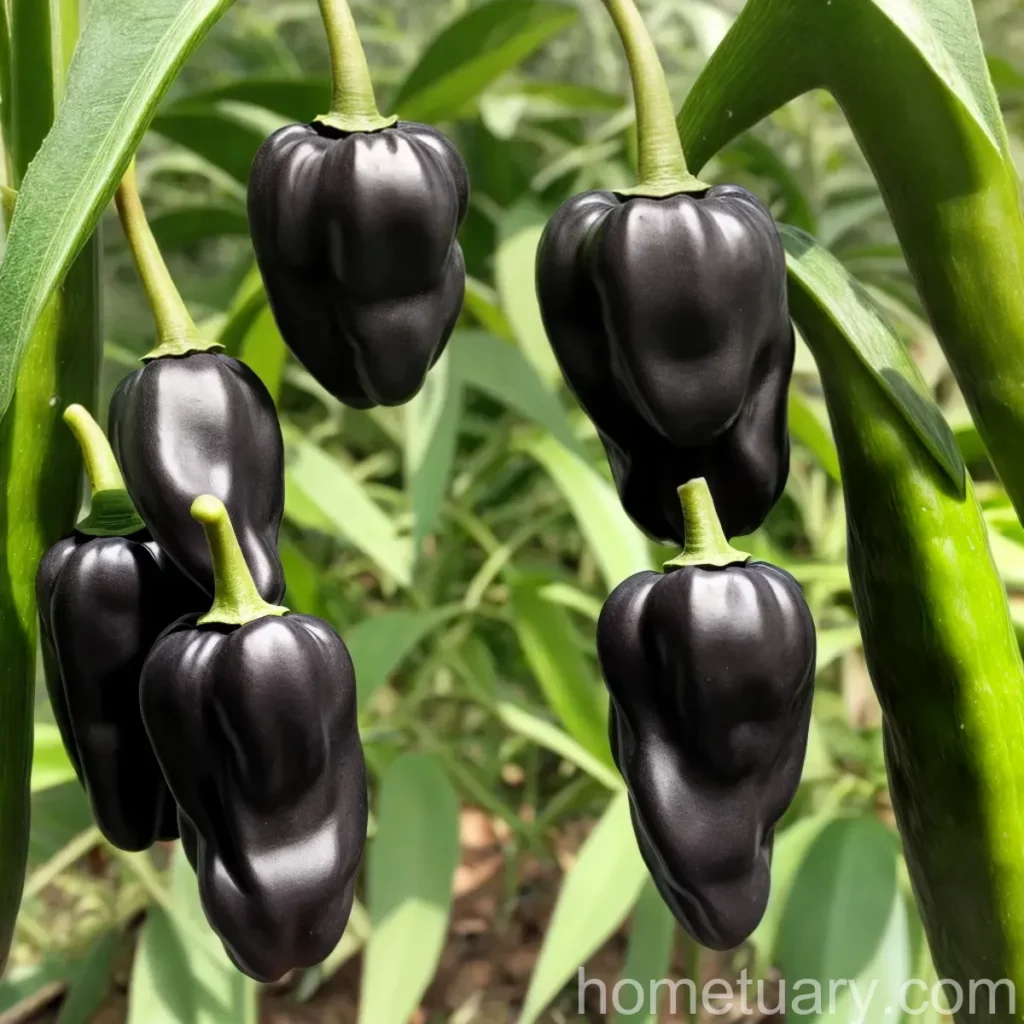The Intriguing World of Common Pepper (Piper nigrum)
From seasoning delectable dishes to being a part of ancient medicinal practices, common pepper, scientifically known as Piper nigrum, has left an indelible mark on human civilization. The Piper nigrum, belonging to the Piperaceae family, is commonly renowned as black pepper or peppercorns, and is a quintessential spice plant. This article is a comprehensive guide to the cultivation, uses, and care of common pepper, delving into its rich history, growth stages, and health management.
What is Common Pepper (Piper nigrum)?
The origins of common pepper can be traced back to the Western Ghats of Kerala, India, where it historically thrived in the tropical climate. The Piper nigrum plant is characterized by slender spikes of tiny white blossoms, which later transform into the clusters of green berries, popularly known as peppercorns. The enchanting aroma and sharp flavor of Piper nigrum have secured its position as a staple in culinary endeavors across the globe. Furthermore, the Piperine compound found in black pepper renders it a valuable ingredient in traditional medicine, making it a multifaceted plant of immense significance.
Key Takeaways – Common Pepper (Piper nigrum)
Before embarking on the journey of understanding the intricacies of cultivating and nurturing the Piper nigrum, let’s take a moment to glance at the key takeaways associated with the common pepper plant:
- Piper nigrum, also known as black pepper, is a member of the Piperaceae family, and its peppercorns are renowned as a quintessential spice across the globe.
- The multifaceted nature of common pepper expands to encompass culinary and medicinal uses, owing to the presence of the Piperine compound.
- Cultivating and caring for the Piper nigrum requires a nuanced understanding of its water, sunlight, soil, and nutritional requirements, in addition to pest and disease management.
With these key takeaways in mind, let’s delve into the various facets of the Piper nigrum, from its cultural significance to practical methods of cultivation and maintenance.
Culture
When delving into the culture surrounding the cultivation and use of common pepper, it becomes evident that it has been an integral part of human lifestyle for centuries. The culinary significance of the Piper nigrum is profound, as it amplifies the taste and aroma of dishes with its distinct pungency. From ancient trade routes to contemporary culinary practices, the popularity of black pepper has transcended time and geographic boundaries, making it an invaluable part of global gastronomy.
Uses
Culinary Uses of Common Pepper (Piper nigrum)
The culinary applications of Piper nigrum are as diverse as they are widespread. The addition of freshly ground black pepper enhances the flavors of savory and sweet dishes alike, ranging from soups and stews to desserts and beverages. Its role in seasoning is indispensable, and its application extends to marinades and rubs for meats. Furthermore, black pepper is featured in the production of pickles, where its tangy zest enlivens the preserved vegetables. The culinary uses of black pepper are a testament to its versatility and enduring appeal in the culinary domain.
Medicinal Uses of Common Pepper (Piper nigrum)
In addition to its culinary prominence, Piper nigrum has been an integral component of traditional medicine systems for centuries. The Piperine compound within the peppercorns is attributed with numerous health benefits, including its potential anti-inflammatory and digestive properties. The traditional medicinal uses of black pepper encompass remedies for indigestion, respiratory issues, and as a catalyst for nutrient absorption. Its role in enhancing the bioavailability of various nutrients has cemented its status as a revered ingredient in traditional medicine practices.
Water
Water plays a pivotal role in the growth and sustenance of common pepper plants. As a tropical plant, Piper nigrum thrives in warm and humid environments, necessitating consistent moisture in the soil. However, it’s essential to strike a balance, as excessive water can lead to root rot and other detrimental conditions. The water requirements of the Piper nigrum are contingent on environmental factors such as temperature and humidity, in addition to the stage of growth and the nature of the soil.
Watering Tips for Common Pepper (Piper nigrum)
- Consistent Moisture: Provide a consistent level of moisture to the soil, ensuring that it’s neither waterlogged nor excessively dry.
- Drip Irrigation: Consider the implementation of drip irrigation systems for precise and efficient water delivery, particularly in larger cultivation settings.
- Monitoring: Regularly monitor the moisture levels in the soil, adjusting the watering frequency and volume as per the plant’s needs and environmental conditions.
Sunlight
As an avid lover of warmth and sunlight, the Piper nigrum flourishes in well-lit settings, benefiting from ample exposure to sunlight. Optimal sunlight exposure fosters robust growth and contributes to the development of flavorful peppercorns, thus underscoring the significance of sunlight in the cultivation of common pepper.
Sunlight Requirements for Common Pepper (Piper nigrum)
- Direct Sunlight: Position the plants in areas that receive direct sunlight, ideally for 6 to 8 hours per day.
- Sheltered Locations: In regions with intense heat, provide partial shading during the hottest periods of the day to prevent excessive stress on the plants.
- Indoor Cultivation: For indoor cultivation, ensure that the Piper nigrum receives sufficient natural or artificial light to meet its sunlight requirements.
Fertilizer
The nutritional requirements of common pepper plants encompass a balanced and tailored approach to fertilizer application. Effective fertilization fosters vigorous growth, enhances flower and fruit development, and bolsters the overall health of the plants. By adhering to appropriate fertilizer practices, the cultivation of Piper nigrum can yield abundant and flavorful peppercorns.
Fertilization Tips for Common Pepper (Piper nigrum)
- Nutrient-Rich Soil: Begin with nutrient-rich soil to create a strong foundation for the plants, supplemented with organic matter for improved fertility.
- Slow-Release Fertilizers: Opt for slow-release fertilizers rich in nitrogen, phosphorus, and potassium, facilitating steady nutrient availability for the plants.
- Seasonal Fertilization: Tailor the fertilizer application to align with the growth stages of the plants, availing of bloom-enhancing fertilizers during the flowering phase.
Soil
The choice of soil for cultivating common pepper holds paramount importance, as it serves as the anchor for the plants and the source of essential nutrients. Creating an environment conducive to the growth of Piper nigrum necessitates a discerning approach to soil composition and structure.
Best Soil for Common Pepper (Piper nigrum)
- Loamy Soil: Opt for well-draining loamy soil with ample organic matter content, promoting healthy root development and moisture retention.
- pH Considerations: The ideal pH range for the soil lies between 5.5 and 7, ensuring optimal nutrient uptake and mitigating the risk of nutrient deficiencies.
- Soil Amendments: Incorporate organic amendments such as compost and well-rotted manure to enrich the soil and bolster its fertility.
Pruning
Strategic pruning plays a pivotal role in the maintenance and productivity of common pepper plants. Pruning facilitates the removal of diseased or damaged foliage, promotes airflow, and supports the development of sturdy and fruitful branches.
Pruning Techniques for Common Pepper (Piper nigrum)
- Regular Inspection: Conduct routine inspections to identify and remove any diseased or damaged branches, in addition to excessive growth.
- Pruning Tools: Employ sharp and sterile pruning shears to make precise cuts, minimizing the risk of tears and infections.
- Training Vines: Encourage the upward growth of the plants by training the vines along supports, lending structure and accessibility for pruning and maintenance.
Propagation
The propagation of common pepper plants offers an avenue for expanding cultivation while preserving the characteristics of favored varieties. Propagation methods such as stem cuttings and layering serve as valuable techniques to perpetuate the lineage of desired Piper nigrum cultivars.
Propagation Methods for Common Pepper (Piper nigrum)
- Stem Cuttings: Select healthy and robust stems for cuttings, ensuring that they possess several nodes for effective rooting and establishment.
- Layering: Encourage the growth of new roots on the parent plant by making an incision and promoting contact with soil, facilitating the development of an independent root system.
Container Popularity
The versatility of common pepper plants extends to container cultivation, allowing enthusiasts to partake in the rewarding journey of nurturing Piper nigrum in confined spaces. Container gardening offers a means to overcome space constraints and provides the opportunity to cultivate black pepper within the confines of urban settings.
Common Diseases
Despite its resilience, common pepper, like many plants, is susceptible to various diseases that necessitate vigilance and proactive management to ensure the long-term health and vigor of the Piper nigrum.
Disease Diagnosis
Accurate diagnosis of diseases affecting common pepper is pivotal in implementing targeted and effective management practices. By discerning the symptoms and attributes of prevalent diseases, plant enthusiasts can take informed steps to mitigate their impact.
Common Pests
The presence of pests poses a potential threat to the robustness and productivity of common pepper plants. Understanding the characteristics of common pests and their modes of infestation facilitates effective pest management strategies, safeguarding the well-being of the Piper nigrum.
Botanist’s Tips
Optimal Cultivation Conditions for Piper nigrum
- Warmth and Humidity: Create an environment that maintains warmth and humidity, simulating the tropical habitat favored by common pepper plants.
- Well-Draining Soil: Ensure that the soil is well-draining to prevent waterlogging, supplementing it with organic amendments for improved structure and fertility.
- Ample Sunlight: Position the plants in locations receiving ample sunlight, either through direct exposure or partial shading in regions with intense heat.
Disease and Pest Management
- Vigilant Monitoring: Regularly inspect the plants for signs of pest infestation and disease development, taking prompt action to mitigate their impact.
- Cultural Practices: Embrace cultural practices such as crop rotation and timely pruning to minimize the risk of diseases and pests.
- Natural Predators: Encourage the presence of natural predators such as beneficial insects to control pest populations and maintain ecological balance.
Fun Facts
- The Piper nigrum is a perennial vine that can reach impressive heights, often necessitating sturdy supports to accommodate its growth.
- The distinct pungency of black pepper is attributed to the presence of Piperine, a bioactive compound with renowned medicinal and culinary significance.
- The historical value of black pepper is reflected in its association with trade routes and economic prosperity, symbolizing its stature as a prized commodity.
Links to External Resources
To further enrich your understanding and appreciation of common pepper (Piper nigrum), consider exploring the following curated resources:
- Pepper Growers’ Guide – University of Florida
- Black Pepper Production and Management – ATTRA
- Cultivation of Black Pepper – Krishi Jagran
- Piper nigrum: Phytochemistry, Botany, and Horticultural Aspects – ScienceDirect
- The Spice that Built Venice – The New York Times
Now equipped with a holistic understanding of the Piper nigrum, you can embark on your journey of cultivating, cherishing, and harnessing the potential of this captivating plant. Whether you’re a culinary enthusiast seeking to elevate your dishes or a horticultural aficionado delving into the nuances of plant care, the common pepper holds an alluring appeal that transcends boundaries and encapsulates the essence of flavor, tradition, and resilience.















